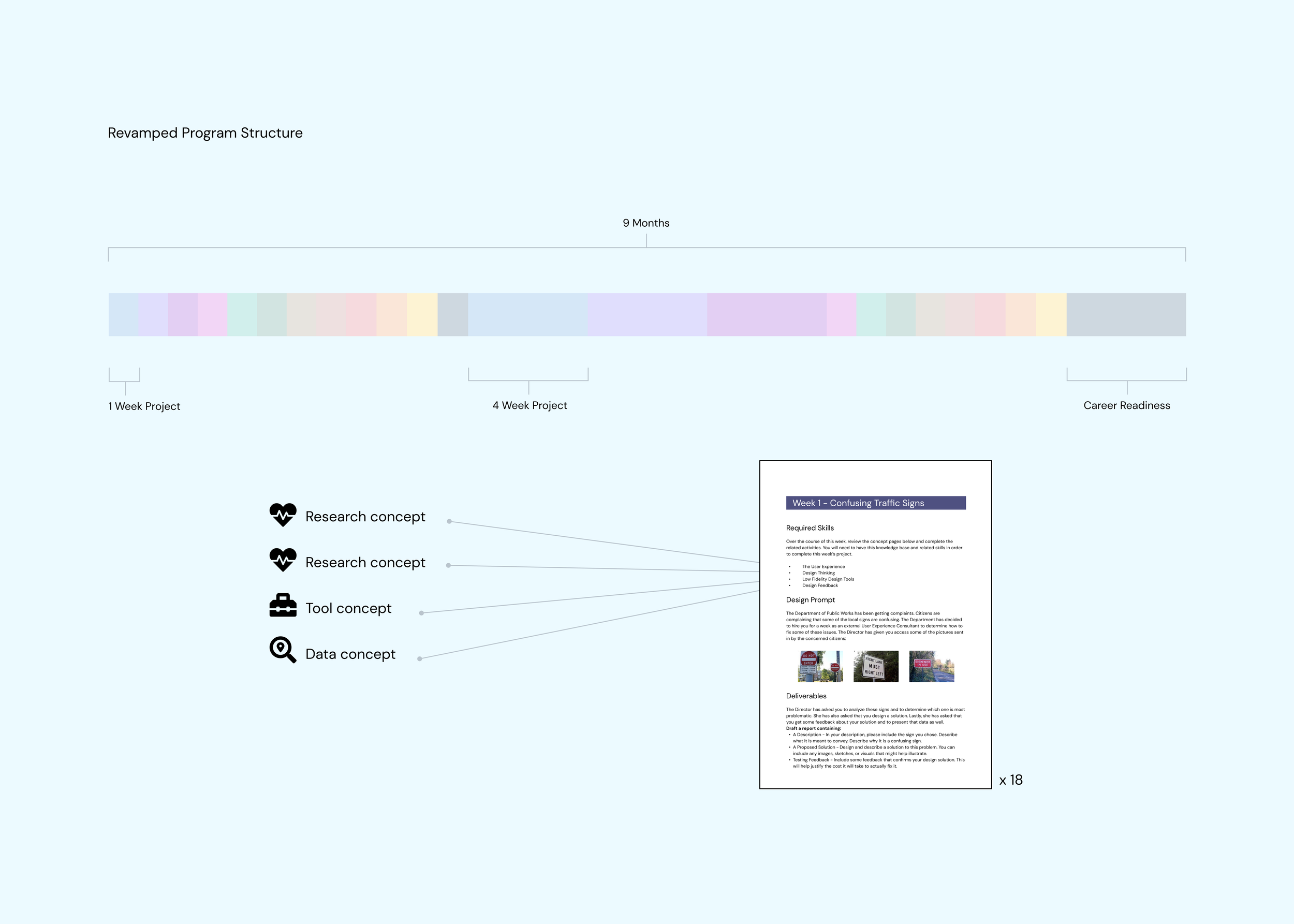UX Design Curriculum
Reinventing UX Design education with a focus on dynamic, flexible, and accessible curriculum.
October 2021 - July 2023

Role:
UX Researcher
Visual Designer
Curriculum Designer
Team:
1 Project Manager
2 Instructional Designers
3 Curriculum Designers
Methods:
Card Sorting, Surveys, Interviews, Metrics, Observations
The Challenge
Southern New Hampshire University had recently acquired Kenzie Academy. In addition to addressing existing shortcomings with the UX Design curriculum, the entire program needed to be restructured in order to align with Southern New Hampshire University Business Needs.
Kenzie Academy’s original full time, synchronous, in-person program needed to be updated to a part time, asynchronous, fully remote program.
The current program structure needed to align with SNHU’s other course offerings.
Prospective students had a hard time committing to the demands of a full time program schedule.
The original 6 month program would be transformed to a 9 month program consisting of 3 terms.
Along with the objectives listed above, multiple User Needs had been identified, collected through weekly surveys, interviews and grading trends. All of which needed to be addressed in the next iteration as well.
Many students would reach graduation without enough projects to include for a strong portfolio, leaving them less than prepared to enter the job market.
The original program contained only 2 main projects: The Foundation Project and The Collaboration Project, each spanning 3 months in length.
Being tied to one project for 3 months at a time, many students felt burnout early.
In rewriting each lesson, this would be an opportunity to address any gaps in the curriculum.

The Approach
We completely restructured and recreated all UX program content, including all visuals, reading materials, assignments, projects and practice exercises in accordance with the needs listed above.
We would no longer require students to apply every phase of design thinking incrementally to a single 3 month project. Instead all associated topics under the design thinking umbrella would be broken down into modular concepts and spread across a multitude of design projects at varying stages. Additionally, a full 4 weeks would be dedicated specifically to career readiness to ensure graduates are as prepared as possible to enter the job market and seek employment.
As we began considering how we might rearrange the full gamut of topics, I decided to seek some outside feedback. I set up and ran a cross-departmental closed Card Sorting exercise with the Product Team to see if a proposed arrangement of UX concepts made sense.
All concepts would remain firmly rooted in Design Thinking. However, the original monotonous, linear framework would be broken. Concept pages were treated as modular elements that could be redistributed and applied in new intriguing ways. During our card sorting sessions, participants were encouraged to arrange 48 Term 1 topics into 5 proposed buckets as labeled below:
Research
Gathering Feedback
Synthesizing Data
UI design
UX Tools
Career Readiness

The Outcome
Big changes were implemented producing an entirely new 36 week program. This final iteration included a much stronger emphasis on portfolio preparedness as well as career readiness during the final four weeks. The part time asynchronous schedule allowed students added flexibility with how they interacted with the program. This access enabled them to participate in coursework, watch recorded class sessions, and access lesson materials when convenient. The new 9 month program contained 18 different projects ranging from 1 week to 4 weeks in length, keeping things fresh and allowing students to apply learnings in various scenarios.
Results
Under the new curriculum model, students no longer reported burnout from working on the same assigned project prompt and user type for a full 3 month timeframe. Instead, students shared enthusiasm with the variety of design prompts and were eager to apply new skills and knowledge.
At times, life circumstances would invariably arise, taking students away from their lessons. Under this new modular structure, students could more freely jump back into the curriculum work, rather than falling behind on a 3 month commitment.
We saw far less dropouts. We achieved a retention rate of 73% for students under the new program structure.
